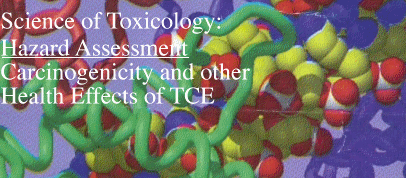 |
||||
 |
||


Risk Assessment is another type of causation: predicting whether an exposure, usually in a population rather than a single individual, will increase the risk of developing some adverse health effect, without necessarily determining whether such health effect actually occurs. Risk means that all such exposed individuals are more likely to develop an adverse effect, but it does not mean that any particular individual will or even that the majority of individuals will. Smoking, for example, increases risk of lung cancer from approximately one in 100 to 1 in 10--a signficiant increase. Nevertheless, ninety percent of smokers do not develop lung cancer, even though they are all at increased risk. Risk Assessment is used by regulatory agencies, such as the EPA, to determine how much of a chemical can be released into the environment without causing an unacceptable increase in risk of an adverse effect. 'Unacceptable' is more of a policty decision than a scientific one.
Specific causation analysis can be divided into the following three components:
(1) Hazard Assessment
(2) Exposure Assessment
(3) Health Assessment
(1) Hazard Assessment: what harm can the chemical cause, based on intrinsic toxicity and circumstnaces of exposure, form of chemical (gas, liquid, solid) and susceptibility of individual.
(2) Exposure Assessment how much of the chemical is in a media (air, water, food, soil) available to be taken into the body? Is this a one-time or multiple exposure? Does it occur over a short period of time (acute) or over many months or years (chronic)? How does the length of exposure affect the toxicity of the chemical? How much of the chemical gets absorbed into the body (dose), and where in the body does it end up (distribution and target organ/tissue)?
(3) Health Assessment: what type of health effect develops (or gets exacerbated), and does this occur immediately or after a delay (lag time)? Is this a new effect in the individual or is there a history of this type of problem, made worse by the chemical exposure? Is the individual in a high risk group (in utero, infant, elderly, reduced immune function)? Are there other (alternative) known causes for this problem and were these causes present ?
Hazard Assessment
The National Academy of Sciences, Board on Environmental Studies and Toxicology, released a 379 page report concerning the EPA risk assessment of trichloroethylene, a common manufacturing agent and degreaser that is found at many of the superfund sites across the United States. It is also found in many of the waterways and groundwater across the United States. EPA issued a draft risk assessment in 2001 which was stopped by the Department of Defense, which claimed that the data was too uncertain and contradictory to justify publication of the risk assessment. As such, it has been on hold ever since. The National Academy of Sciences was asked to evaluate the risk assessment, the quality of the data and of the methodology, although it was not asked to conduct a risk assessment itself. NAS did note shortcomings and weaknesses, but none it found justified stopping the publication of the report or of questioning the findings from 2001. NAS noted that since 2001 additional data has strengthened knowledge of the carcinogenic effects, as well as other health impications, of TCE, and suppport EPA's findings. At the same time NAS directs EPA to improve some of the techniques and to clarify certain issues with the risk assessment.
Currently EPA regulations allow 5 parts per billion in drinking water. The draft report calls for lowering this to 1 part per billion. If that is adopted it could have great repercussions on cleaning up waterways and on effects at hazardous waste sites. The Defense Department has 1400 sites with TCE contamination that would have to be cleaned up, the reason some claim that the Department was attempting to delay publication of the risk assessment.
TCE is believe to be involved in and potentially cause kidney cancer, as well as other kidney ailments, although the exposures required for this are not known. TCE may also be involved in liver cancer, although possibly at much higher concentrations.
The NAS report also explicitly rejected Defense Department claims and those of the chemical industry that TCE is much less hazardous at very low concentrations. NAS did not agree with this.